U.S. Back in Deflation; Inflation Scare Ends; Hyperinflationists Wrong Twice Over
Economics / Deflation Aug 12, 2011 - 06:51 AM GMTBy: Mike_Shedlock
 Hyperinflationits have now blown it twice. First, they insisted hyperinflation would happen before deflation. They were wrong. Then, during the QE2 inspired equities and commodities ramp, they said the same thing. They were wrong again.
Hyperinflationits have now blown it twice. First, they insisted hyperinflation would happen before deflation. They were wrong. Then, during the QE2 inspired equities and commodities ramp, they said the same thing. They were wrong again.
Prior to the Great Financial Crisis I had a bet with "Heli-Ben", a staunch hyperinflationist who insisted we would hyperinflation before deflation. I won the bet but have not yet received my prize, a "crying towel" from "Heli-Ben".
By any rational measure, and certainly by my definition, the US went into a period of deflation lasting at least a year. Deflation ended in March of 2009.
In the wake of QE II hyperinflationists again started preaching about hyperinflationary crashes. Once again, and with increasing intensity, we heard things like ...
- The US is Zimbabwe
- No food available at any price
- Oil is going to $200, then $400
- Excess reserves will pour into the economy causing massive inflation
- No one will be willing to hold US dollars
- Treasury rates are going to the moon
- The US dollar is going to zero
I could assign names to the above list, but I won't.
Two well-known hyperinflationists confidently predicted hyperinflation would start this year. A third said 2011 or 2012 giving himself extra time to be proven wrong.
My position all along was that the US would go in and out of deflation over a period of years, just like Japan.
I am claiming my "crying towel" prize for the second time. The US is now undeniably back in deflation. If "Heli-Ben" does not submit a "crying towel" his word is as good as his economic theories, which is to say worthless.
Definition of Terms
Before discussing terms one must define them. I have on numerous occasions defined mine, and my definition was the basis for the bet.
Inflation
Inflation is a net increase in money supply and credit, with credit marked-to-market.
Deflation
Deflation is a net decrease in money supply and credit, with credit marked-to-market.
Hyperinflation
Complete loss of faith in currency.
The first two definitions have nothing to do with prices per se, the third does (by implication of currency becoming worthless).
Price Myopia
Many if not most economists, especially Keynesians, think of inflation in terms of prices.
In contrast, Austrian-minded economists generally have definitions similar to mine except most of them fail to properly include credit in their analysis. Austrians in general look at money supply alone, and that is a huge mistake.
Role of Credit in Inflation
Failure to include credit in the definition of inflation and the analysis of economic activity causes many problems. Credit influences consumer prices, jobs creation, and asset prices. The mark-to-market value of credit influences the ability and willingness of banks to lend.
People tell me all the time, "all I care about is prices". If they really mean it, they are fools. Without credit expansion there is little hiring. Without hiring and money to pay for things, consumers cannot pay back loans and asset prices in general, crash.
Trillions of dollars in debt-inflated (thus imaginary) wealth have been wiped out in housing and the stock market because of falling credit, loss of jobs, and inability to service debt. Many homes fell in price from $500,000 to $200,000 (or equivalent percentages).
This is far more important than the price of gasoline hitting $4 or the price of carrots rising 50% to $2 a bunch. Yet, inflationists constantly fret about prices, ignoring far more important credit conditions.
Price myopia has other problems. Both Greenspan and Bernanke ignored an explosion of credit that fueled housing. Thus, a focus on prices induced errors on the way up and on the way down.
Fed Ignorance
The massive bubbles in credit and housing, were a direct consequence of Fed ignorance. Bernanke failed to see a recession and a housing bubble that would have been obvious to anyone using a proper definition of inflation.
I cannot tell someone what their definition should be, I can only point out the complete foolishness of concern over prices vs. rapid expansion or contraction of credit and credit marked-to market.
Humpty Dumpty on Inflation
Please consider this paragraph from my post Humpty Dumpty On Inflation written December 2008.
Humpty Dumpty Defines InflationWhen I wrote "Humpty Dumpty on Inflation", the U.S. was unquestionably in a period of deflation. However, I also clearly pointed out "Every deflationist on the planet understands inflation will be back at some point and the Fed will attempt to do everything it can to avoid it."
Unfortunately there are many definitions of inflation and deflation strewn about. Some play the role of Humpty Dumpty changing meanings at whim, switching from commodity prices, to consumer prices, to expansion of base money or M3 or whatever measure of money seems to be expanding at the fastest rate.
Some do the inflationista two-step to avoid admitting that we are indeed in deflation, choosing instead to call it "disinflation"
In short: "We are going to have a period of deflation that we will instead call disinflation."
'When I use a word,' Humpty Dumpty said, in a rather scornful tone,' it means just what I choose it to mean, neither more nor less.'
'The question is,' said Alice, 'whether you can make words mean so many different things.'
'The question is,' said Humpty Dumpty, 'which is to be master - that's all.'
It appears that the deflationista camp is incapable of comprehending a model, and the events that it forecasts, that lays out a two step process. For some reason they cannot grasp the fact governments will respond to disinflation with inflation, that the impact of those interventions is not instantaneous, and that markets historically are not very good at foreseeing the change in inflationary conditions in either direction.
Not quite. Rather it appears that some who suggested there would never be deflation are gracefully attempting to back into it, and indeed going out of their way with a two-step to pretend it is something else.
Every deflationist on the planet understands inflation will be back at some point and the Fed will attempt to do everything it can to avoid it.
In retrospect, the word "every" in the above sentence is too strong.
Regardless, I explicitly pointed out deflation was not permanent while also stating on numerous occasions that the US would be back in deflation, and indeed we are.
In "Humpty Dumpty" I listed conditions (symptoms) one would expect to see in deflation, as follows.
Symptoms of Deflation
- Falling Credit Marked-to-Market
- Falling Treasury Yields
- Falling Home Prices
- Rising Corporate Bond Yields
- Rising Dollar
- Falling Commodity Prices
- Falling Consumer Prices
- Rising Unemployment
- Negative GDP
- Falling Stock Market
- Spiking Base Money Supply
- Banks Hoarding Cash
- Rising Savings Rate
- Purchasing Power of Gold Rises
- Rising Number of Bank Failures
Scorecard
When you go to a doctor for diagnosis of an illness, the first thing the doctor inquires about is symptoms. So let's do just that for the second time.
Let's take those 15 conditions one would expect to see in deflation and see how many apply.
1- Falling Credit Marked-to-Market
The mark-to-market value of credit on the balance sheets of banks and financial institutions is the hardest of the 15 items to measure. Indeed, the mark-to-market value of credit cannot be directly measured at all.
The reason is banks do not mark-to-market assets unless those assets are worth more than they paid for them. The Fed, FDIC, and FASB (Financial Accounting Standards Board) lets banks get away with just that. Mark-to-Market rule enforcement has been postponed twice. Moreover, banks hide non-performing loans off the balance sheet in SIVs and by other tactics.
However, one can easily impute the direction of of the value of credit on the balance sheets of banks and financial institutions by watching prices of bank shares.
In 2008 shares of financial corporations plunged. In March 2009, financial assets valuations soared. That action kept up for longer than I expected.
However, early this year, bank stocks started showing weakness (long before the rest of the market), then crashed in the last couple weeks.
$BKX Banking Index
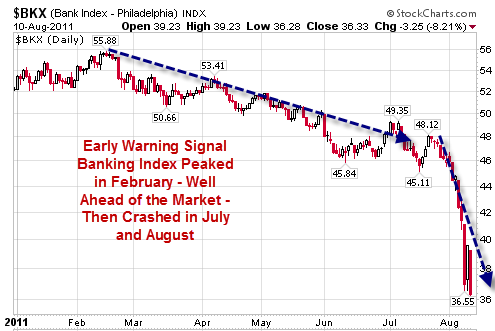
The $BKX banking index is down a whopping 35% since February. Clearly the market has re-evaluated the mark-to-market value of credit on the balance sheets of banks. In a plunge like this, far greater than the overall market, there is no room for any other interpretation.
Pater Tenebrarum presents a superb analysis of the situation of U.S. and European banks in Welcome Back To The GFC, written August 11, 2011.
Bank of America (BAC) find itself increasingly under suspicion from investors, as it continues to choke on its acquisitions made during GFC, Phase 1. Readers may recall our comments on the take-over of Countrywide by BAC – at the time we noted that in our view, the takeover was done because Countrywide was one of the biggest counterparties of BAC. By taking it over, the losses that would have come due on occasion of Countrywide's bankruptcy could be swept under the rug. Moreover, BAC had invested a lot of money in Countrywide and strove to make it appear as though these investment had been wise. That the then management of BAC paid such a high price in the takeover was clearly a dereliction of its fiduciary duties. It could have gotten the carcass a few weeks later for next to nothing. Instead it decided to pay a high price for what has likely turned into a sheer bottom-less well of losses. This was then topped off with the acquisition of Merrill Lynch, likely at the behest of the administration – again in order to avert what would likely have become a major bankruptcy otherwise. If this reminds you of the story of Creditanstalt in the early 1930's, we say it should. BAC appears to be on the brink again. Its new management keeps saying that no new capital will have to be raised and that the bank's 'fundamentals are strong', but since it continues to sell 'non-core assets' at a fast clip, it evidently does need more capital. The market's verdict is rather worrisome. That is one small clip in a lengthy but very worthwhile discussion that also includes credit default swap analysis of numerous US and foreign banks.
Nothing Fundamental Ever Changed
It is important to point out that nothing fundamental ever changed in regards to the health of US and European banks. They were and still are bankrupt. However, what did change (temporarily), is the market's mark-to-market valuation of bank assets.
Alternatively, the market was willing to overlook suspect assets, perhaps in belief that rising earnings would eventually cover the losses and more capital would not have to be raised.
The recent plunge in bank shares globally, shows without a doubt the market once again questions the value of debt on the balance sheets of banks. Once that happened everything fell apart, quite rapidly.
Those not paying attention to mark-to-market issues never saw this coming. The debt-deflationists did.
2 - Falling Treasury Yields
Yield Curve as of 2011-08-10
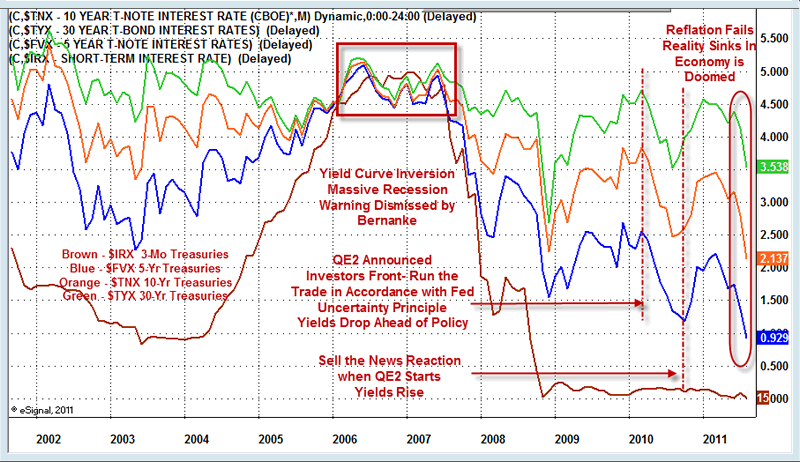
Shades of Japan
03-Mo = .01%
06-Mo = .06%
12-Mo = .09%
02-Yr = .18%
03-Yr = .33%
05-Yr = .92%
07-Yr = 1.50%
10-Yr = 2.15%
30-Yr = 3.51%
2-year, 5-year, and 10-year treasury yields hit all-time lows on 2011-08-10. This happened in spite of a downgrade of US debt by the S&P.
3 - Falling Home Prices
The Case-Shiller home price index briefly turned positive in 2010 but is now down 4% year-over-year. 10 years of price gains have been wiped out in many cities.
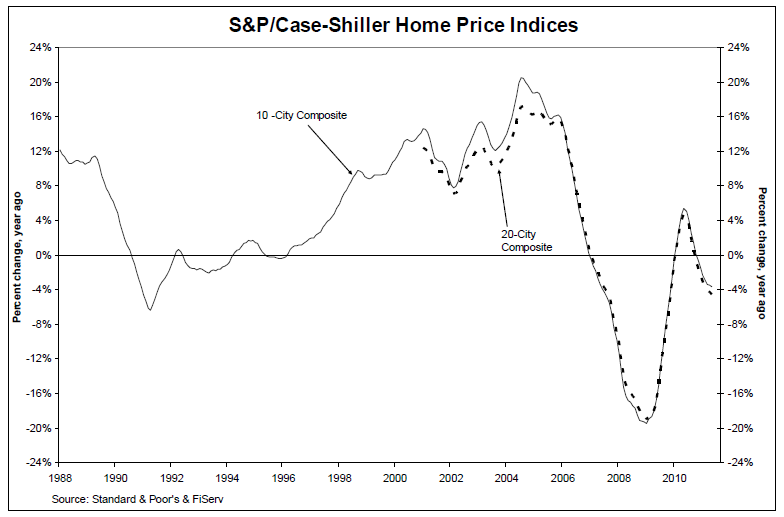
4- Rising Corporate Bond Yields
My proxy for corporate bonds is JNK, the Lehman High-Yield Junk Bond Index. When risk appetite drops, prices fall, and yields rise.The rapid decline in price represents a rise in yields and a reduced demand for disk.

So far we are four for four.
5 - Rising Dollar
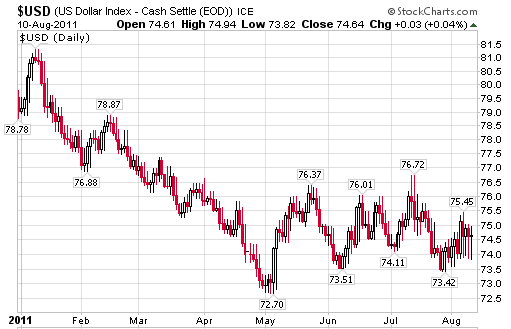
Clearly that is not much of a rally. However, equally clearly the US dollar bottomed in May. That makes five for five.
6 - Falling Commodity Prices
Producer Price Index Finished Goods
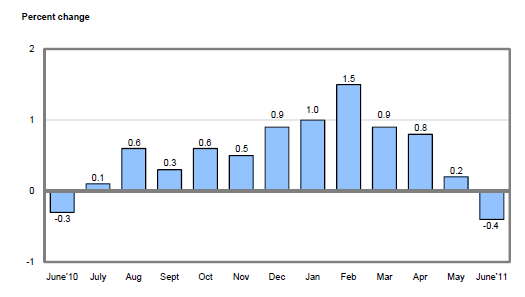
Producer Price Index Intermediate Goods
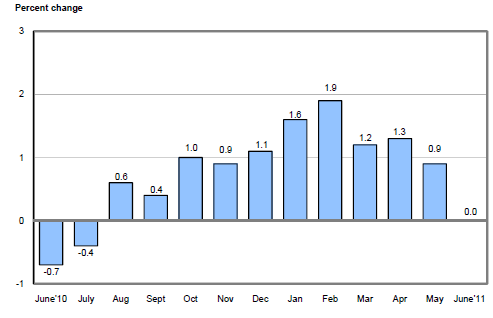
Producer Price Index Raw Goods
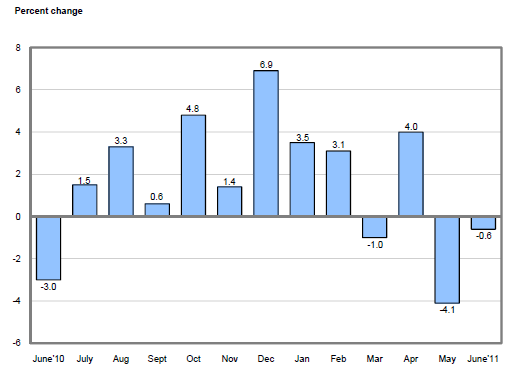
The above charts from the BLS PPI Release.
$CRB - Commodities Index
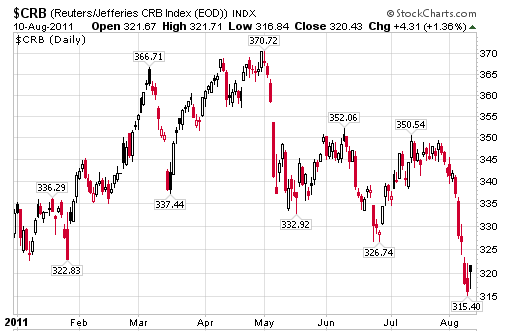
Commodities peak in May, the same time the PPI went negative.
This makes six for six.
7 - Falling Consumer Prices
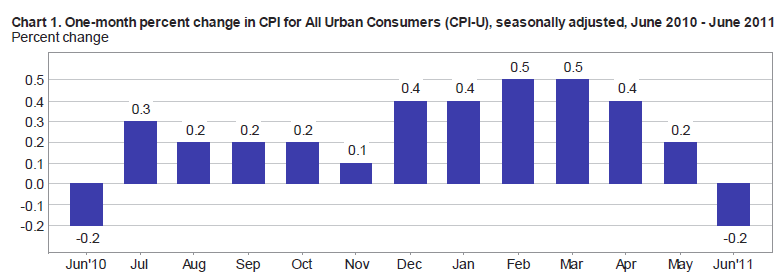
The above chart from the BLS CPI Release
This data point is the weakest of the lot so far given that it is a month-over-month comparison rather than year-over-year. However, in the wake of plunging crude prices, gasoline prices will drop as well. More CPI weakness will follow.
This makes seven for seven.
8 - Rising Unemployment
Let's consider both Employment and Unemployment.
Employment

There was never a rebound in employment from the last recession.
Unemployment Rate
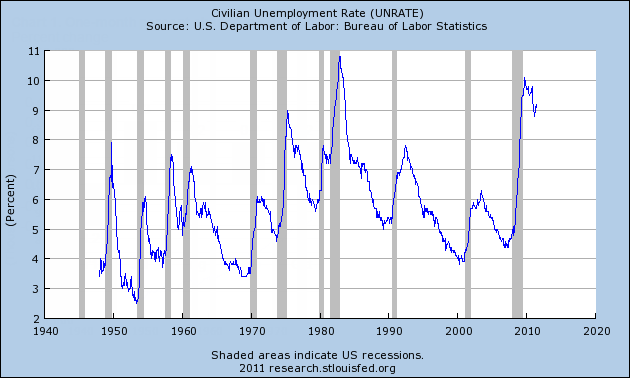
The unemployment rate remains higher than the peak high of all previous recessions. Moreover, the unemployment report would be above 11% were it not for people dropping out of the labor force.
Let's wrap up with a look at numbers from the latest jobs report.
Household Data
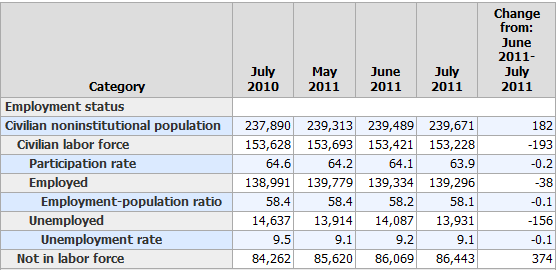
The number of people employed fell by 38,000!
The only reason the unemployment rate dropped is 193,000 people dropped out of the labor force. Why? Because most of them became so discouraged they stopped looking for work. And if you stop looking for work, even if you want a job and need a job you are not considered unemployed.
The preponderance of evidence is clear.
This makes eight for eight.
9 - Negative GDP
The BEA Gross Domestic Product: Second Quarter 2011 release states "Real gross domestic product -- the output of goods and services produced by labor and property located in the United States -- increased at an annual rate of 1.3 percent in the second quarter of 2011, (that is, from the first quarter to the second quarter), according to the "advance" estimate released by the Bureau of Economic Analysis. In the first quarter, real GDP increased 0.4 percent."
This is exceptionally weak. Indeed I think GDP is below the stall rate and the US is headed for recession. I wish I had worded the condition a bit more thoughtfully. In a period of deflation GDP will be weak, not necessarily continually falling.
However, let's call this a near miss.
This makes eight for nine.
10 - Falling Stock Market
I could produce hundreds of charts for this category but let's go with the S&P 500 Index.
$SPX Daily
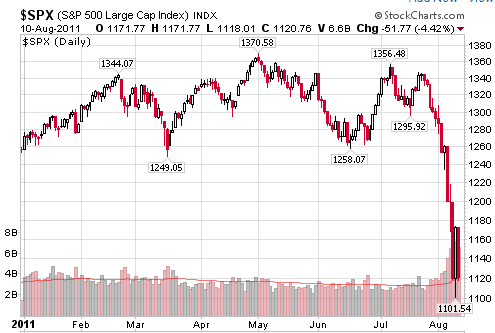
That makes 9 for 10.
11 - Spiking Base Money Supply
That spiking money supply would spike in deflation is counterintuitive. Yet, if one concentrates on expectations of what the Fed would do to combat deflation, that expectation is crystal clear.
However, like a drug addict on heroin, the medicine has worn off. The money sits as excess reserves at the central bank.
Base Money Supply
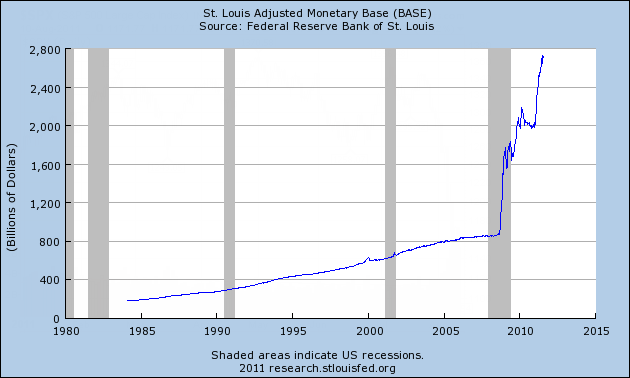
The Fed is clearly fighting (and now losing) the battle against deflation.
That makes ten of eleven.
12 - Banks Hoarding Cash
I wrote about banks hoarding cash and paying negative interest rates on deposits on August 4, 2011 in Bank of New York Mellon to Slap Fees on Big Deposits Following "Global Dash For Cash"; When was Hyperinflation Supposed to Start?
Excess reserves is another measure of willingness to lend.
Excess Reserves
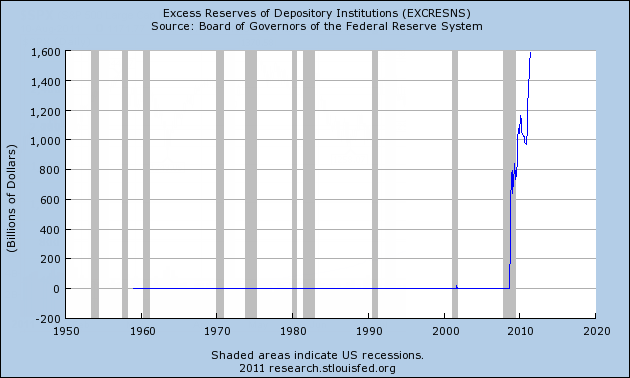
Excess Reserve Money-Multiplier Theory is Fatally Flawed
Some have written these "excess reserves" are waiting in the wings to cause massive inflation.
It did not happen nor will it. Simply put, the excess-reserve money-multiplier theory is potty.
Banks do not lend just because they have reserves. Indeed reserves do not enter the equation at all. Rather, banks lend as long as they are not capital impaired and as long as they have good credit risks willing to borrow.
In this case, banks are capital impaired, and there are too few credit-worthy clients who want to borrow. The result is banks do not lend and money sits as excess reserves.
That makes eleven of twelve.
13 - Rising Savings Rate
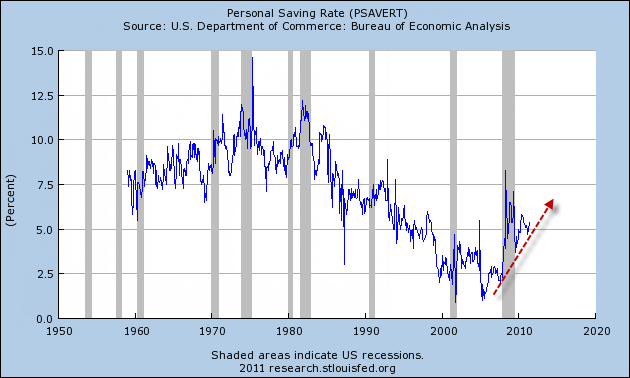
The savings rate bottomed in 2007 and has generally been rising since. The rate is below the spike highs mid-recession, but the latest tick is up and the uptrend line is intact.
That makes twelve of thirteen.
14 - Purchasing Power of Gold Rises
Many deflationists thought gold would drop in deflation. However, my theory, explained years ago is as follows:
- Gold is money
- Gold is in the senior currency rises in value in deflation.
- Gold, as money, would would benefit (rise) in response to Fed actions to defeat deflation by printing fiat money.
It happened in the great depression and it is happening again.
That makes thirteen of fourteen.
15 - Rising Number of Bank Failures
Bank closings remain elevated. We have had 106 bank failures so far in 2011.
That makes fourteen of fifteen
Doctor, Doctor Gimme The News
If you went into a doctor and had 14 of 15 symptoms of a disease and the 15th was close, you can be sure the doctor would know what was happening.
In this case, the diagnosis is crystal clear: The US is back in deflation.
Who Called This?
Robert Murphy, in End This Agony on the Ludwig von Mises Institute says no one saw this coming.
To my knowledge, no school of economic thought predicted all of the major trends back in, say, January 2008. The conventional Keynesians employed at the White House and in major forecasting firms were completely wrong about the Obama stimulus package. The "crowding out" Chicago School types were completely wrong about the deficit's impact on interest rates. People like Peter Schiff (and yours truly) were completely wrong about consumer price inflation in 2009 and 2010. The "quasimonetarists" (who blamed Bernanke for his allegedly tight money policies) and Paul Krugman were completely wrong about gold and silver prices, and arguably about the fragility of the "recovery" in the stock market.I take strong exception to Murphy's analysis. I offer as proof, Murphy's November 22, 2010 in Has Mish Deflated the "Inflationistas"?
Over the last two years, I have gotten perhaps dozens of requests to "deal with" the deflationist approach of Mike "Mish" Shedlock.So Robert Murphy who got it right?
Mish's Framework: Credit, Deflation, and Gold
A good summary of Mish's views comes from a September 2010 blog post — it was this one that spurred me to write the current article, egged on by a reader who enjoys both Mish and my own work. Mish writes,Day in and day out I hear it from readers who insist that we are not in deflation and will not be in deflation because prices are rising and continue to rise. …
Such comments come from those who are not thinking clearly about what's important. Here's why:
In a fiat credit-based financial system, when credit is plunging businesses are not hiring. There are currently 14.9 million unemployed who want a job but do not have a job because businesses are not hiring. … This is all related to the ongoing credit contraction.
When credit is plunging so do yields on treasuries and in turn yields on savings accounts. …
When business earnings are under pressure or when business owners face uncertainty over consumer spending trends, businesses cut back on benefits, especially health care. Those with health care benefits are asked to chip in more of the costs. This too is a function of deflation.
When profits are weak and business uncertainty high, stock prices do not act well (at least in the long run). Those with 401Ks or personal investments are affected.
With credit falling and wages stagnant or falling, anyone in debt is likely to have a harder time paying back that debt. Foreclosures rise so do bankruptcies and divorces. Entire families have gone homeless. …
Expanding credit (inflation) created an enormous housing bubble, a commercial real estate boom, a rising stock market, and an enormous number of jobs.
Contracting credit (deflation), burst the housing bubble, burst the commercial real estate bubble, burst the stock market bubble, resulting in millions of foreclosures and bankruptcies, millions of broken homes, millions on food stamps, 26.2 million unemployed or partially employed, and countless additional millions who are underemployed.
People notice food and energy prices because they tend to be somewhat sticky. Everyone has to eat, heat their homes, and take some form of transportation at times, but is that what's important?
No!
In the grand scheme of things, nominal increases in food and energy prices are but a few grains of salt in the world's largest salt-shaker compared to the massive effects of rising or falling credit conditions.
So we see that Mish takes great exception to those Austrians (especially Peter Schiff) who have been warning of inflation. Rather than focusing on statistics such as the monetary base (which has exploded since the crisis in the fall of 2008), Mish defines "inflation as a net expansion of money supply and credit, with credit marked-to-market. Deflation is a net contraction of money supply and credit, with credit marked-to-market." ....
Murphy goes on-and-on about some of my short-term predictions that I missed. However, none of his rebuttal dealt with my theories a reader asked him to rebut!
I discussed Murphy's inability to address deflation theory in my response Failure to Consider Constraints
By the way, before anyone tells me ways the Fed can and will cause inflation, my rebuttal in advance is in the above link on constraints.
Also, and for the record, please note Bernanke's Deflation Preventing Scorecard.
Bernanke has failed to prevent deflation twice!
Murphy, Gary North, Peter Schiff and many other Austrian-economists missed constraints on the Fed and the importance of debt-deflation. That is two very bad misses.
Let me ask again, if Bernanke wants 2% inflation, home prices to go up, and asset prices to go up, why aren't they? And why are those excess reserves that North and Murphy said would come surging into the market still sitting there?
There are others who got this right as well, namely Australian economist Steve Keen and a few of my credit-minded long-wave friends.
I have learned a lot from Steve Keen and I thank him greatly. Most Austrians have refused to consider (or simply fail to understand) debt-deflation analysis and how it would impede the Fed's ability to spawn the inflation Bernanke wants, let alone the massive inflation Murphy, Schiff, and North all saw coming.
In his latest article, Murphy attacked the credibility of Krugman on inflation when Krugman got inflation (in relation to prices and treasury yields) more correct than Murphy.
To be fair, I vehemently attack Krugman all the time myself, but I pick my battles carefully. Just because someone is nearly always wrong on solutions, does not make that person wrong on everything.
Krugman made a short post the other day called That Was The Inflation Scare That Was
Point blank, Krugman is correct. Yes, it was an inflation scare. Bear in mind, Krugman has a definition of inflation I do not agree with. By Krugman's PCE measure, we are still in inflation. Regardless, I still laugh at all the inflationists and hyperinflationists who predicted massive inflation starting in 2011.
That said, I disagree with Krugman and side with Murphy on nearly every solution to every problem. Krugman's cures are fiscal madness.
In general Keynesians propose throwing more money at the problem, a setup that will inevitably lead to 200 percent debt-to-GDP problems like Japan, then a spectacular blowup as we saw in Greece.
Who got inflation picture right?
- Debt deflationists like Steve Keen
- Austrians who incorporated debt-deflation into their theories.
- Arguably Paul Krugman, in accordance with his definition
It pains me to defend Krugman, especially at the expense of Murphy, but those are the facts. Since those are the facts, let's not make self-serving claims that no one got the call correct.
Indeed, some select few of us (primarily in group 2 above) got, gold, treasuries, and deflation all correct, and more importantly, for the right reasons: careful analysis of debt-deflation and the impact debt-deflation would have on gold and US treasuries.
Krugman may have failed to include debt-deflation in his analysis but that is better than being wrong after being warned numerous times about the impact of debt-deleveraging and the fallacious idea that excess reserves were going to cause a massive sudden spike in inflation.
The debt-deflationists trounced the Austrians on that point.
Special Mention
I have had many feuds with Eric Jantzen at iTulip regarding deflation. He makes a distinction between deflation and debt-deflation. From a practical standpoint, in a fiat credit-based economy, debt-deflation is deflation.
Jantzen does not see it that way, preferring to call the effect "disinflation". However, a rose by any other name is still a rose and some of my arguments with Jantzen are best described as "violent agreement" about what is happening but disagreement about what to call it.
Moreover, I have nothing but praise for Jantzen's call back in 2002 "buy gold and hold on to it". He explicitly said gold, not miners, not CALLs, not other equities. The long-term trendline of gold is intact. The only other intact long-term trendline is US treasuries.
Janstzen got the gold portion of his macro-call correct. Jantzen also managed to include some "debt-deflation" analysis in his thinking, something most of the Austrians failed to do altogether.
I do not know Jantzen's record on treasuries. I do know mine. When the price of crude was $140 I called for record low treasury yields across the entire yield curve and most people thought I was crazy. I certainly missed the strength of the rebound in equities in 2010, but that chapter is still not closed as should now be readily apparent.
Finally, Jantzen's definition of inflation pertains to the purchasing power of the dollar and prices of goods and services. By that definition, Jantzen has been generally correct. Prices, have generally gone up except for very short periods of time.
However, and as I have pointed out, prices of goods and services is not what has mattered most. Trillions of dollars wiped out in housing and the debt-deleveraging that continues is still is far more important to the economy than prices of food and energy.
Practically Speaking
From a practical standpoint of economic analysis of the economy, debt-deflation (deflation) and consumer deleveraging is of paramount importance and is likely to remain of paramount importance for some time, no matter what definition one assigns to the process.
Austrian economists, as well as hyperinflationists with myopic eyes focused solely on money supply instead of debt, and everyone with ill-conceived notions of the power of the Fed, better figure that out in a hurry or they risk more horribly blown macro calls.
By Mike "Mish" Shedlock
http://globaleconomicanalysis.blogspot.com Click Here To Scroll Thru My Recent Post List
Mike Shedlock / Mish is a registered investment advisor representative for SitkaPacific Capital Management . Sitka Pacific is an asset management firm whose goal is strong performance and low volatility, regardless of market direction.
Visit Sitka Pacific's Account Management Page to learn more about wealth management and capital preservation strategies of Sitka Pacific.
I do weekly podcasts every Thursday on HoweStreet and a brief 7 minute segment on Saturday on CKNW AM 980 in Vancouver.
When not writing about stocks or the economy I spends a great deal of time on photography and in the garden. I have over 80 magazine and book cover credits. Some of my Wisconsin and gardening images can be seen at MichaelShedlock.com .
© 2011 Mike Shedlock, All Rights Reserved.
© 2005-2022 http://www.MarketOracle.co.uk - The Market Oracle is a FREE Daily Financial Markets Analysis & Forecasting online publication.



